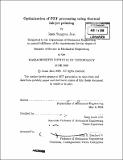Optimization of PZT processing using thermal ink-jet printing
Author(s)
Jeon, Jessie Sungyun
DownloadFull printable version (6.357Mb)
Alternative title
Optimization of lead zirconate titanate processing using thermal ink-jet printing
Other Contributors
Massachusetts Institute of Technology. Dept. of Mechanical Engineering.
Advisor
Sang Gook Kim.
Terms of use
Metadata
Show full item recordAbstract
Lead zirconate titanate (PZT) has been known for its strong piezoelectric property for micro-sensors and actuators. Yet, its use in MEMS has been constrained by limitations in processing PZT with current MEMS fabrication technology. The direct printing of PZT, in place of traditional manufacturing process such as spin-coating, enables on-demand deposition, allowing flexibility in thickness and shape of PZT deposition with a lower material cost. This thesis reports the thermal process optimization of the direct printing method to ensure the quality of PZT products. The pyrolysis portion of the thermal processing condition has been analyzed to show that pyrolysis performed at 360°C for 2 hours removes a sufficient amount of organic additives. There also exists a positive correlation for the duration of pyrolysis and the amount of desired perovskite phase crystal structure formed. The multi-layer printing has been experimented to remove the PZT voids in the sample. However, P-V curve or resistivity data were unable to show much improved performance. This is believed to be caused from the degradation of PZT, which were left under humid condition before the final annealing process. Further investigation will be continued to confirm the effect of multi-layer printing.
Description
Thesis (S.B.)--Massachusetts Institute of Technology, Dept. of Mechanical Engineering, 2008. Includes bibliographical references (leaves 28-29).
Date issued
2008Department
Massachusetts Institute of Technology. Department of Mechanical EngineeringPublisher
Massachusetts Institute of Technology
Keywords
Mechanical Engineering.